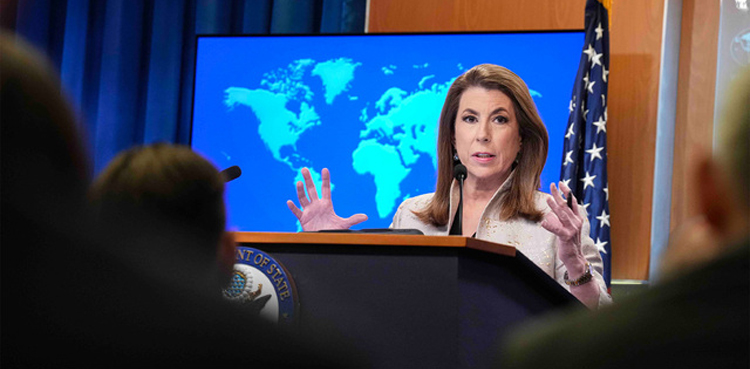WASHINGTON: The United States (US) has urged India and Pakistan to resolve their differences through dialogue, as tensions between the two South Asian rivals persist despite a ceasefire.
Following the Trump administration’s intervention to halt escalating hostilities between the two nations, India has temporarily suspended its participation in the Indus Waters Treaty with Pakistan. This move has raised concerns about regional stability and potential water shortages in Pakistan, as the treaty governs the sharing of waters from the Indus River system.
“We encourage both countries to engage in direct communication to resolve these issues,” a State Department spokesperson told ARY News when asked to comment on the Indian government’s decision to suspend the Indus Waters Treaty.
Pakistan considers the move an act of war, noting that over 240 million Pakistanis rely on this water supply for agriculture and basic survival.
The Indus Waters Treaty (IWT) is a water-sharing agreement between India and Pakistan, signed on September 19, 1960, and brokered by the World Bank. It has been instrumental in managing the waters of the Indus River System — a network of six rivers (Indus, Jhelum, Chenab, Ravi, Beas, and Sutlej) that originate in the Himalayas and flow through both countries before emptying into the Arabian Sea.
Key Aspects of the IWT:
1. River Allocation
Western Rivers (Indus, Jhelum, and Chenab): Primarily allocated to Pakistan, which receives roughly 80% of the total water carried by the Indus system.
Eastern Rivers (Ravi, Beas, and Sutlej): Allocated to India for unrestricted use.
2. India’s Usage of Western Rivers
India is permitted limited use of the Western Rivers for domestic purposes, irrigation, and non-consumptive activities like power generation, navigation, and fishing. However, the treaty imposes restrictions on India’s ability to construct dams that could store or significantly alter the flow of these rivers, according to NPR.
3. Dispute Resolution Mechanisms
The treaty includes a structured approach to resolve disputes:
Permanent Indus Commission: A bilateral body responsible for routine cooperation and information exchange.
Neutral Expert: Appointed by the World Bank to resolve technical “differences.”
Court of Arbitration: Convened on an ad hoc basis to address significant “disputes.”
4. Historical Context and Recent Challenges
The IWT is considered one of the most successful international water treaties, having endured through wars and periods of heightened tensions between India and Pakistan for over six decades.
However, recent Indian hydroelectric projects on Western Rivers — such as the Kishanganga and Ratle — have triggered concerns in Pakistan about reduced downstream flows vital for its agriculture and energy production.
5. Perspectives on the Treaty
Pakistan: Regards the treaty as critical to its agricultural and hydropower sectors. It sees any Indian attempts to restrict water flow as an existential threat and stresses strict adherence to treaty provisions.
India: Believes the treaty imposes undue limitations on its development needs and has called for modifications, arguing the agreement does not reflect present-day political or environmental realities. India has also criticized what it sees as Pakistani obstruction of its hydropower initiatives.
6. Climate Change
Experts note that the treaty does not account for the effects of climate change — particularly the accelerated melting of Himalayan glaciers — raising concerns about the future sustainability of water resources for both countries.


Leave a Comment